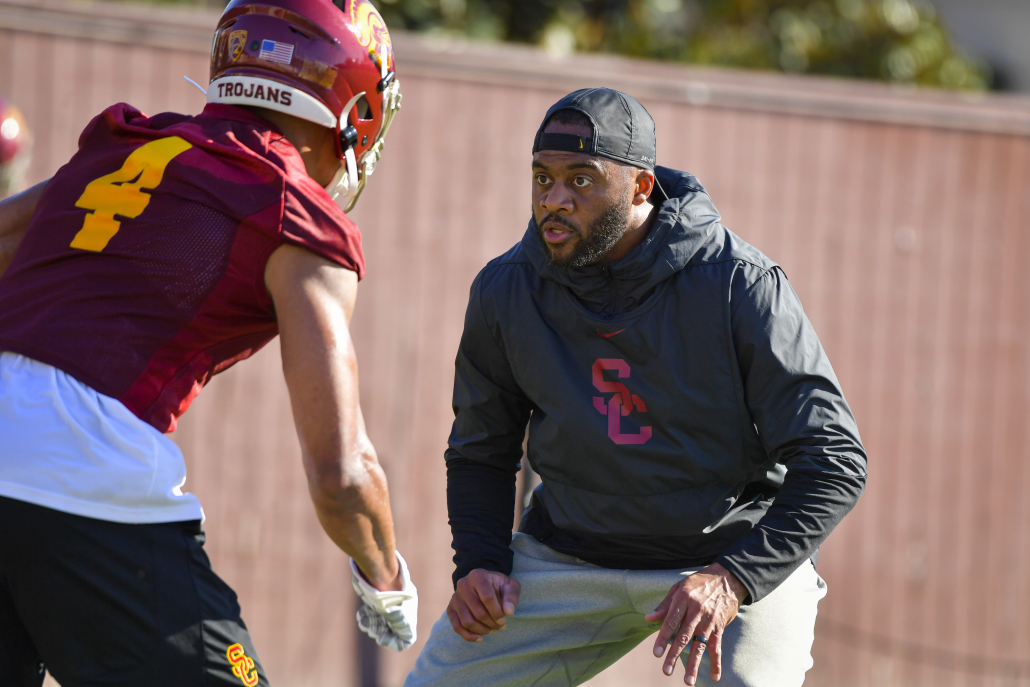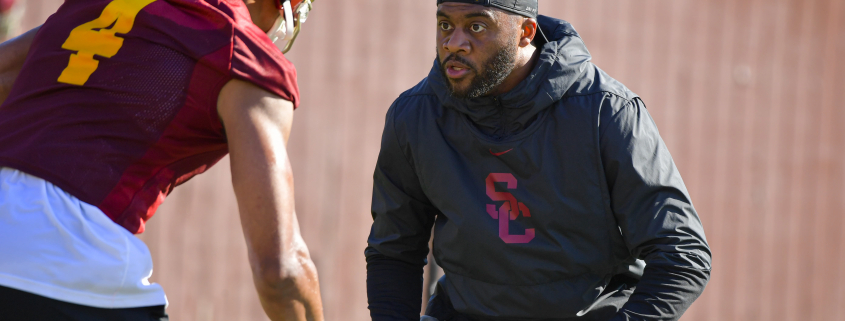Q&A with Trojans wide receivers coach Keary Colbert

Sports editor David Ramirez spoke to USC wide receivers coach Keary Colbert about his approach to recruiting, game planning and mentoring USC’s talented crop of pass-catchers. Colbert himself was a standout receiver at USC before being selected in the second round of the 2004 NFL Draft.
David Ramirez: What do you think is the biggest difference between college football now and when you were playing?
Keary Colbert: It’s a great question. I think the social media piece. It is a lot different, obviously. Especially with the name, image and likeness coming about in college football. I think college kids now have a larger platform to stand on. Their faces are out there a lot more. I mean, you don’t have to be the star player on the team to have a following or a fan base. I think that’s a big difference in college football today.
I think recruiting is different. Partly because of social media, the ability to have access to a lot of different recruits for coaches. It makes it a lot easier to be seen and to be noticed if you’re a high school kid. Back in the day, if you wanted to be recruited, you’re sending out VHS tapes and coaches had to physically come and see you play — they’re not just sending an email or a text message with a Hudl link and stuff like that. So that makes recruiting kind of go a little more nationally in my opinion.
From the game standpoint, I think it’s a lot more spread out as far as style of play, whereas in the past it was a little bit more smashmouth football — downhill run, play action, stuff like that. Now, of course, there are teams that still do that and there’s still situations where you see that in games, but I think the ability to kind of play in space and make defenses defend every blade of grass that there is, I think that’s a big difference in today’s game.
DR: I’m curious as to what approach you take when it comes to a game week. Are you the type of person that’s always trying to improve, always trying to make changes and little tweaks up until the very last moment or do you have a certain time where you’re like, “I’m just going to set it and forget it?”
KC: Yeah, for me personally, I like to leave it. I like to get to a point of the game or the week where I just leave the player, leave the receivers alone and just let them play. At the end of the day, we do a lot of heavier preparation earlier in the week and then it kind of tails back. We scale it down a little bit, we refine it and then at the end of the day we recruit our guys because they’re talented football players and I don’t like to “over-coach.” Personally, I like to just give them the freedom to go out there and be who they are naturally and just trust that all that we’ve done in the week of preparation will be enough.
Of course, on game day and during the game, I’m their set of eyes. We have other coaches that are their sets of eyes that can help them see things, process things, give answers to the test while we’re out there. So I don’t really like to take up too much of a player’s time because I didn’t really like that as a player. You know, I like to kind of prepare my own way, especially the day of a game or night before a game and stuff like that. Everybody has their own process now — of course, there’s guys that have questions and want to meet. We make that time available for them. I’m saying I’ll do whatever I have to to help somebody be as prepared as possible for a game. But for me, I like to just kind of cut them loose, man, trust the process and let them go play.
DR: As a fan it’s very easy to say “start this guy” and “bench this guy” because you don’t know them as human beings. You deal with these people on a daily basis, you know them much greater than what they are as athletes. How do you handle that weight knowing you’re dealing with people’s livelihoods? You’re making decisions, but at the same time it’s affecting people very deeply.
KC: Yeah, that’s probably the toughest part about coaching. Everybody works really hard during the week and everybody puts in a lot of time and effort into this game and the sport and the team. But not everybody’s results are the same.
At the end of the day, it is our duty as coaches to do what’s best and right for the team and hard decisions have to be made. The best players play. Sometimes it’s not that other players are not good players. It’s just that there might be a slightly better player in front of you at the time, but as long as guys trust the process, you just never know what happens. I mean, I’ve seen it.
DR: Do you have a game day superstition? Anything that you have to do on a game day before a game?
KC: When I walk up the tunnel at home games, I always touch all the wide receivers that are on the wall inside when you go through the tunnel. There’s pictures of all the great players, I touch all the wide receivers and then also touch my roommates Carson and Troy and some of the guys that I’ve played with that I’m really close to. It’s something that I’ve been doing since I played at USC. It’s something that continues all the way up until now every time I walk in the Coliseum.
DR: How do you feel about the group that you have right now?
KC: Honestly, I’m really sad about the season being postponed. I’m saying that because this is literally the best collection of wide receivers that I’ve ever been associated with — and I’m talking about from a playing standpoint to a coaching standpoint. I’m talking about top to bottom. I’ve been around some great wide receivers. As a group — from one to nine or one to however many is in the room — as a collection, this is one of the best groups that I’ve been a part of.
I just hate that they’ve been working so hard; I hate that they don’t get to go out and show it. I mean, obviously, it was a good group last year, and I really think that we were in the process of taking another step up.
That’s what I say about the group: They work really hard. They push each other, which is probably the best thing because when you have good players, the bar keeps rising. You can have good players that just kind of do their thing and you have other players down at the bottom, but when good players push one another and bring another person out of them, it raises the bar in the room. I’ll tell you, man, they’re special. I haven’t been around a collection of wide receivers like them.
DR: There’s a lot going on right now — public health, social justice, a lot of different things. If there’s anything going into this that you wanted to make sure you got off your chest, you want to make sure you had heard, I just wanted to give you that chance.
KC: I just spoke about my frustration, our frustration as a group, our frustration as a team. I think it’s important to understand that there are bigger issues going on bigger than ourselves.
We have to find a way to be better individually and try to be better collectively within our communities. Our guys on our team have done a great job giving back the last couple weeks. They’ve spoken to youth organizations and youth football teams, baseball teams, basically about what’s going on in society and about just everybody continuing to get better and keep their head down, to not be down about the times and just understand that this is a moment. And we have to be aware of the moment; we have to respect the moment; and we’re all fighting for a better cause and we need to all come out of this individually better.
I think if we can do that individually, then collectively, you have better communities, you have better society, etc. So I commend our guys for being available to elementary and junior high kids by way of Zoom. We’ve set up some Zoom meetings with some youth teams and it’s been really impactful. The kids loved it.
So it was our idea to really encourage the youth as well. To understand that you’re not going through this alone. We’re all going through this together. Fight this fight and Fight On, really. So I’ll end it on that.
This interview was edited for length and clarity.

